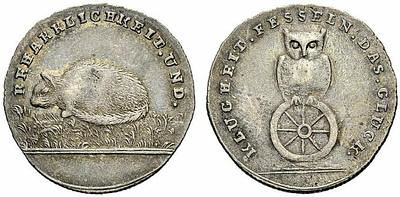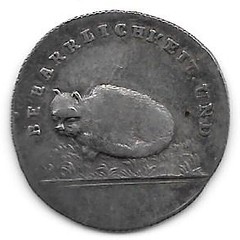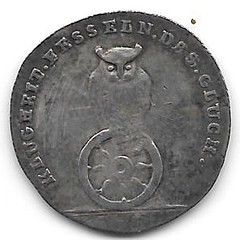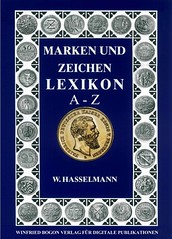
PREV ARTICLE
NEXT ARTICLE
FULL ISSUE
PREV FULL ISSUE
MORE ON BERGRECHNUNGSMARKELast week David Pickup asked about the following item. He wrote: "It is an interesting looking piece but I have no idea what it is!"

Tom Casper writes: In the 7-12-15 issue of E-Sylum, under the heading of 'What Are Bergrechnungsmarke?', I recognized this token from a piece in my collection. My token is a variety of that token, showing a full face cat. Attached are scans of my piece. It appears to be silver, 23mm with a reeded edge. A loose translation of the legends read, "Perseverance and wisdom tied together with luck". I found one entry on the internet picturing this token. It was listed in a 2013 auction by the Emporium Hamburg Auction. The cataloger listed this token as from the city of Clausthal in the Harz Mountain region of Germany. It sold for 70 Euro. To see the complete catalog description, go to their website, https://www.numisbids.com/n.php?p=lot&sid=433&lot=1403


Tom Casper's Piece Henk Groenendijk writes: The term “Bergrechnungsmarke” is listed in: Wolfgang Hasselmann: Marken und Zeichen Lexikon, Lexikon für die im deutschsprachigen Raum aus Metall geprägten Marken und Zeichen. Bergrechnungsmarke is described as (translated): 'Tallies used in mining to account for delivered ore, waste material or for any other work. Served as a basis to determine the wages of miners.'
The token is also illustrated in the Lexikon where the following description is given: “Beharrlichkeit und Klugheit fesseln das Glück, (Harz, um 1805)” Which can be translated as: "Perseverance and wisdom shackle Luck", (Harz region of Germany, issued about 1805). The legend is nicely depicted on the token by a cat lying in wait (perseverance) and an owl (wisdom) sitting on a wheel (wheel of fortune). No further information about this token is given in the Lexikon. I found several references to his token. One of these is in: Münz- und Medaillen-Kabinett des Grafen Karl zu Inn- und Knyphausen, Hannover 1872, Supplement 1875. (CS9301) under the heading “Bergrechnungsmarke”. The description is as follows:

The token is described as made of silver, the weight is given as 3/16 loth, which equals 2,92 gram. Three different dies are recorded. As the token is made of silver it will not have been used by the miners. It likely is either an off-metal strike or a special issue for the directors or administrators of the mine. I was unable to find any information about a catalogue called Elbesh.
Thanks, everyone! The design makes sense now. Interesting.
-Editor
David Pickup adds: My thanks to the correspondents. I wonder how the cat got to Aylesbury!
To read the earlier E-Sylum article, see:

Wayne Homren, Editor The Numismatic Bibliomania Society is a non-profit organization promoting numismatic literature. See our web site at coinbooks.org. To submit items for publication in The E-Sylum, write to the Editor at this address: whomren@gmail.com To subscribe go to: https://my.binhost.com/lists/listinfo/esylum All Rights Reserved. NBS Home Page Contact the NBS webmaster 
|
